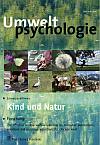Artikeldetails
 Melanie Basten, Silvia Fränkel & Daniela Sellmann-Risse (2021),
Melanie Basten, Silvia Fränkel & Daniela Sellmann-Risse (2021),Do boys and girls feel equally in touch with nature? – Gender differences in outdoor experiences and connectedness to nature among primary school children
(Fühlen sich Jungen und Mädchen gleich stark in Kontakt mit der Natur? – Geschlechterunterschiede in Naturerfahrungen und Naturverbundenheit bei Grundschulkindern).
Umweltpsychologie 25(2), 134-151.
Dieser Artikel wurde in englisch verfasst.
| Zusammenfassung: | Die Menschen in westlichen Ländern, v.a. Kinder, haben sich von der Natur entfremdet. Naturverbundenheit ist jedoch ein starker Prädiktor für Umwelthandeln und von verschiedenen Faktoren abhängig, u.a. den Naturerfahrungen und dem Geschlecht. Die Studienlage bezogen auf Kinder im Grundschulalter ist jedoch dünn und die Befunde uneinheitlich. Die vorliegende Studie ging daher der Forschungsfrage nach, ob sich Jungen und Mädchen hinsichtlich ihres Aufenthalts in der Natur und ihrer Naturverbundenheit unterscheiden. 285 Grundschüler*innen (Alter: M = 9.14, SD = 0.46; 41,1 % Mädchen) wurden in einem Prä-/Post-Interventionsdesign zu ihrem Aufenthalt in der Natur und ihrer Naturverbundenheit befragt. Die Naturverbundenheit wurde mit der Inclusion of Nature in Self-Skala (INS) und der Scale for Differentiating Affective and Cognitive Nature Connection Dimensions, die kognitive und affektive Aspekte der Naturverbundenheit unterscheidet, erfasst. Es zeigte sich, dass die Kinder angaben, sich häufig in der Natur aufzuhalten. Diese Angabe war vom Vor- zum Nachtest bei ca. 60 % der Kinder stabil. Beides war unabhängig von ihrem Geschlecht. Auch die Naturverbundenheit unterschied sich nicht substanziell zwischen Jungen und Mädchen. Vor dem Hintergrund bisheriger uneinheitlicher Befunde und Studiendesigns sowie fehlender validierter Instrumente mit geschlossenen Items zur Messung der Naturverbundenheit bei Kindern ergibt sich für zukünftige Studien weiterer Forschungsbedarf. |
| Schlagworte: | Bildung und Erziehung Geschlechterkluft Nachhaltige Entwicklung |
| Abstract: | People in western countries, especially children, have become alienated from nature. However, connectedness to nature is a strong predictor for environmental behaviour. The connectedness to nature depends on various factors, including the experience in nature and gender. With regard to children of primary school age, however, the study situation is sparse and the findings are inconsistent. We therefore investigated whether boys and girls differ in their time spent in nature and their connectedness to nature. 285 primary school children (age: M = 9.14, SD = 0.46; 41.1 % girls) were surveyed in a pre-/post-intervention design regarding their time spent in nature relojes de imitacion and their connectedness to nature. The connectedness to nature was assessed using the Inclusion of Nature in Self scale (INS) and the Scale for Differentiating Affective and Cognitive Nature Connection Dimensions. It was found that the children indicated that they spent a lot of time in nature. This information was stable from pre-test to post-test in approximately 60 % of the children. Both results were independent of the children's gender. Also the connectedness to nature did not differ substantially between boys and girls. Against the background of previous inconsistent findings and study designs as well as the lack of validated instruments to measure the connectedness to nature in children with closed items, further research is needed. |
| Keywords: | Education Gender Gap Sustainable Development |
Zum Inhaltsverzeichnis

